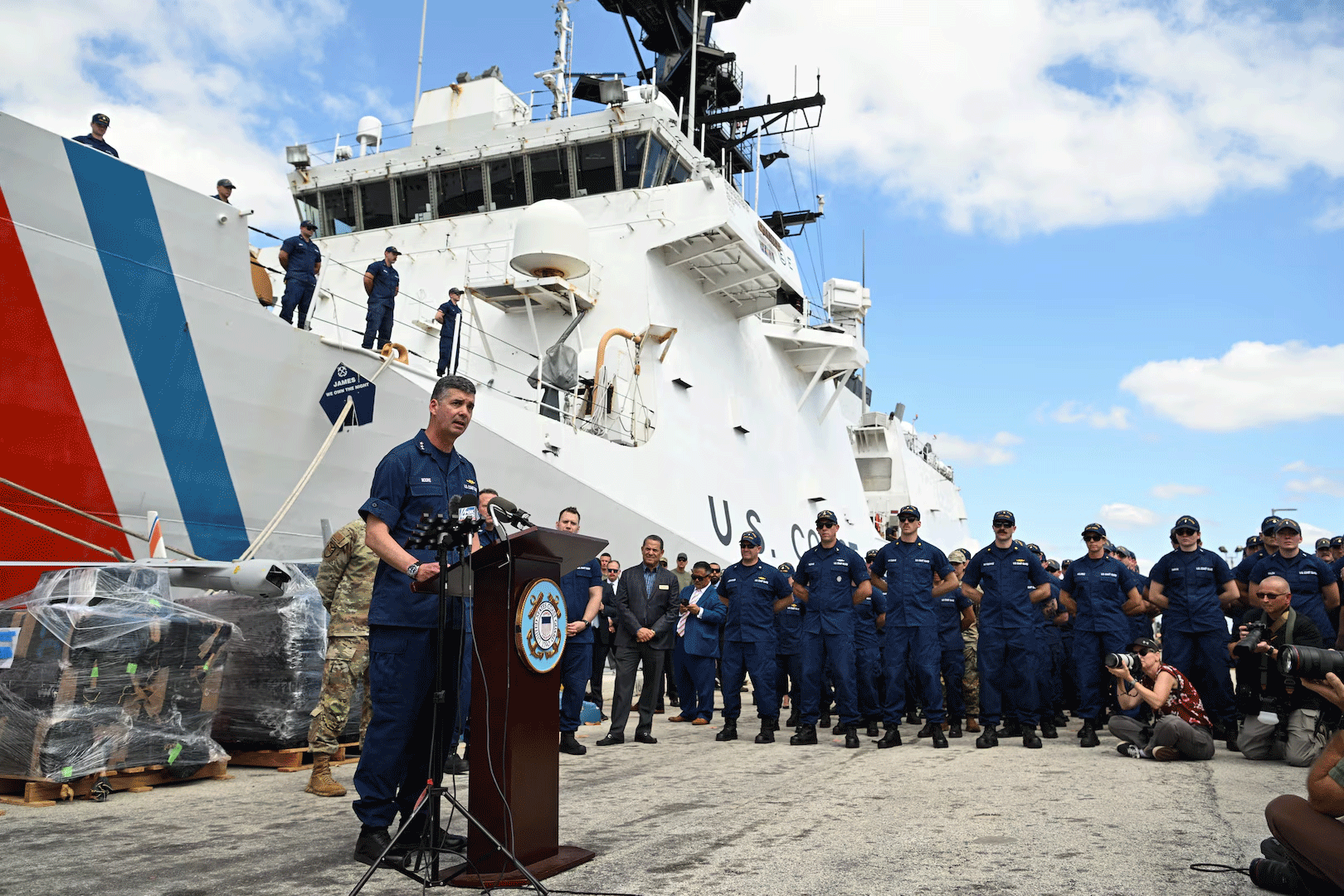U.S. Coast Guard Cutter James offloaded more than 44,550 pounds of cocaine and 3,880 pounds of marijuana valued at approximately $509.9 million in Port Everglades, Wednesday.
This patrol resulted in 11 interdictions in the Eastern Pacific Ocean and the detainment of 34 suspected drug traffickers who were transferred ashore to face federal prosecution. All of these interdictions are tied to criminal investigations by federal partners and are linked to transnational criminal and foreign terrorist organizations including the Clan del Golfo, Sinaloa Cartel, and Cartel Jalisco Nueva Generacion.
“This is a key example of the Department of Justice working with our law enforcement partners to fight crime and keep drugs from flowing into America,” said Attorney General Pamela Bondi. “Thanks to the incredible work of the Coast Guard and FBI, these drugs will help lock up criminals instead of ruining lives.”
On Jan. 5, James’ embarked unmanned aircraft system (drone) spotted a suspicious vessel approximately 260 miles off the coast of Ecuador. James’ boarding team interdicted the vessel, apprehending three suspected smugglers and seizing more than 2,025 pounds of cocaine.
On Jan. 6, a maritime patrol aircraft spotted three suspicious go-fast vessels approximately 280 miles off the coast of Ecuador. James simultaneously intercepted the three go-fast vessels, with the help from the embarked UAS and Coast Guard Helicopter Interdiction Tactical Squadron aircrew, James’ boarding teams interdicted the vessels, apprehending nine suspected drug traffickers and seizing more than 13,960 pounds of cocaine.
On Jan. 7, a maritime patrol aircraft detected a suspicious low-profile go-fast vessel approximately 330 miles off the coast of Galapagos Islands, Ecuador. James’ embarked HITRON aircrew employed airborne use of force tactics to compel the non-compliant vessel to stop, and the boarding team apprehended three suspected drug traffickers and seized over 8,240 pounds of cocaine.
On Jan. 11, a U.S. Customs and Border Protection, Air and Marine Operations aircrew detected a suspicious go-fast vessel approximately 275 miles off the coast of Ecuador. James’ boat crew and Coast Guard Cutter Stone’s embarked HITRON aircrew interdicted the go-fast vessel, apprehending three suspected drug traffickers and seizing more than 3,385 pounds of cocaine.
On Jan. 18, Coast Guard Cutter Mohawk’s crew detected a suspicious go-fast vessel, approximately 185 miles off the coast of Ecuador. After the suspected smugglers jettisoned the presumptive narcotics into the water, James’ small boat chased down the fleeing go-fast from 60 nautical miles away while Mohawk’s crew recovered the jettisoned bales. James’ boarding teams interdicted the go-fast vessel, apprehending three suspected drug traffickers and seizing approximately 5,950 pounds of cocaine.
On Jan. 30, James’ embarked UAS crew detected multiple suspicious go-fast vessels approximately 380 miles west off the coast of Peru. James’ boarding team employed surface use of force tactics to interdict the go-fast vessel, apprehending three suspected drug traffickers and seizing more than 3,870 pounds of cocaine.
On Feb 1, James’ embarked UAS crew spotted a suspicious go-fast vessel operating approximately 280 miles off Ecuador. James’ boarding team interdicted the vessel, apprehending three suspected drug traffickers and seizing more than 3,630 pounds of cocaine.
On Feb. 3, James’ embarked UAS crew detected multiple suspicious go-fast vessels operating 215 miles off Peru. James’ boarding team interdicted the vessel, apprehending three suspected drug traffickers and seizing nearly 3,490 pounds of cocaine.
On Feb. 15, a CBP-AMO aircrew spotted a suspicious go-fast vessel, operating 260 miles off Costa Rica. James’ embarked HITRON aircrew employed airborne use of force tactics to compel the non-compliant vessel to stop. James’ boarding team interdicted the vessel, apprehending four suspected drug traffickers and seizing nearly 3,880 pounds of marijuana.
“I could not be prouder of the James crew and the teams who embarked with us to stand the watch over the holidays to keep our border secure and keep Americans safe,” said Capt. Thomas Rodzewicz, commanding officer of James. “Over a remarkable 72-hour period, our crews interdicted six go-fast vessels and one low-profile vessel across the vast ocean, culminating in the extraordinary seizure of over 24,000 pounds of cocaine and 15 suspected narco-traffickers. We delivered a substantial blow to narco-terrorism organizations, sending those attempting to bring drugs to our border to face federal prosecution, halting the profits criminals use to fuel the fentanyl trade, and most importantly, preventing deadly contraband from reaching American communities and families.”
The following assets and crews assisted James in the interdiction operations:
- U.S. Coast Guard Cutter Mohawk (WMEC 913)
- U.S. Coast Guard Helicopter Interdiction Tactical Squadron (HITRON) Jacksonville
- U.S. Coast Guard Tactical Law Enforcement Team-Pacific (PAC-TACLET)
- U.S. Customs and Border Protection, Air and Marine Operations (CBP-AMO) aircrews
- Joint Interagency Task Force-South (JIATF-S)
Detecting and interdicting illicit drug traffickers on the high seas involves significant interagency and international coordination. The Joint Interagency Task Force-South, based in Key West, is responsible for detecting and monitoring the aerial and maritime movement of illegal drugs. When an interdiction is imminent, the operation transitions to the law enforcement phase, with the U.S. Coast Guard taking control for the interdiction and apprehension stages. Interdictions in the Eastern Pacific Ocean are performed by members of the U.S. Coast Guard under the authority and control of the Eleventh Coast Guard District, headquartered in Alameda, California.

